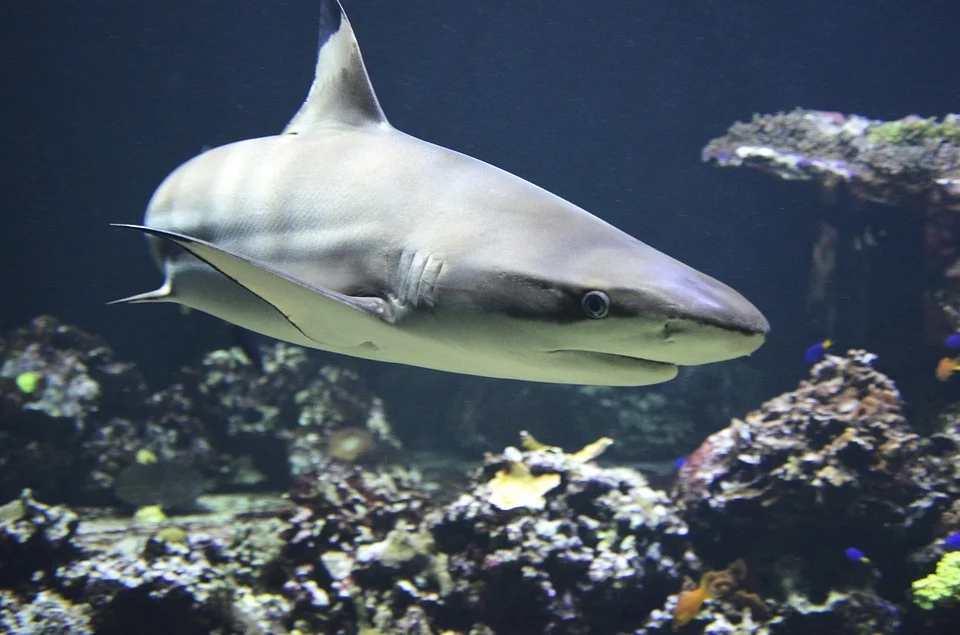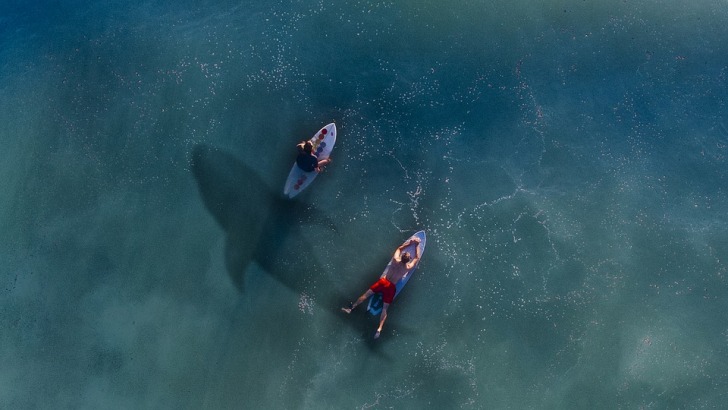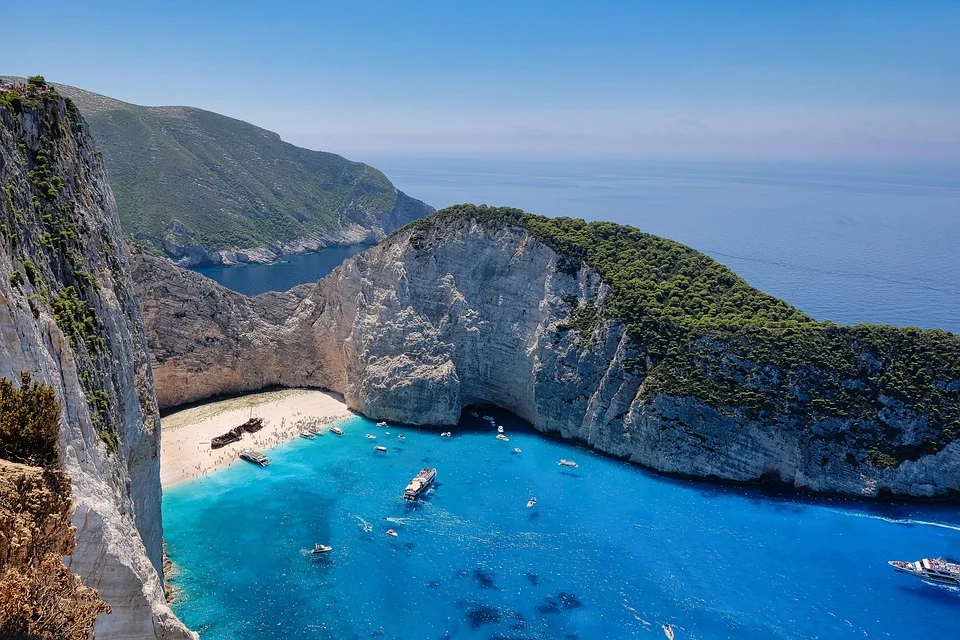Due to the lasting effects of Jaws and other shark-related films in Hollywood, sharks have had a mostly negative reputation in our society.
The resulting “Jaws effect,” a term coined in 2015 by Save Our Seas project leader Christopher Neff, shows us how much the media has impacted people’s framing of sharks and shark encounters.
Contrary to popular belief, sharks are not quite the violent, blood-thirsty, human-eating predators the media makes them out to be.
In fact, most of them are not interested in eating humans, and they actually play a pivotal role in keeping marine ecosystems healthy.
Sharks live in all five of the world’s oceans (Pacific, Atlantic, Arctic, Indian, and Southern), as well as many of the seas connected to those oceans.
One of those seas, the Mediterranean Sea, is home to 47 shark species.
Below you will find more information about Selachimorpha (the scientific name for sharks) that inhabit the Mediterranean and the different species that can be found in this body of water.
Contents
- So… Are There Sharks in the Mediterranean Sea?
- Shark Species in the Mediterranean Sea
- Is it Safe to Swim in the Mediterranean Sea?
- Interesting Shark Facts in the Mediterranean Sea
- Sharks in Freshwater Vs. Saltwater
- 3 Safety Tips for Swimming in Shark-infested Waters
- Summary
- Sources
- Frequently Asked Questions
So… Are There Sharks in the Mediterranean Sea?
Yes.
There are 47 shark species in the Mediterranean Sea.
The 2.5-million-square-kilometer sea also supports a variety of shark habitats, from coral gardens to rocky reefs to sandy bays.
Although sharks are widely believed to be dangerous to humans, the sharks inhabiting this body of water are largely harmless, some of which dwell in the deep sea with no chance of ever encountering a casual human swimmer.
In addition, some of the shark species are so rare that anyone, including a marine scientist, would be hard-pressed to find one even if they tried.
Unfortunately, a large number of shark species are endangered.
Their shrinking numbers are primarily due to habitat destruction (e.g., water pollution), global warming, and overfishing.
With more than half of their species either being endangered or threatened, the sharks of the Mediterranean sea are among the most at risk.
The sharks of the Mediterranean may not be there forever, but here are some of the best-known species that currently can be spotted in this body of water.

- Blue Shark – This species is one of the Mediterranean’s most common sharks. Due to its fairly large size (often reaching a length of 10 feet), many humans tend to be afraid when catching sight of this mostly harmless creature. However, blue shark attacks on humans are quite infrequent, with fatal attacks being extremely rare. Since 2016, the blue shark has been considered a critically endangered animal.
- Great White Shark – Although this species is responsible for the most fatal attacks on humans, they are not a common sight in the Mediterranean. Growing up to 20 feet in length, weighing as much as 2 tons, and darting at speeds of up to 16 miles per hour (25.75 kilometers per hour), the Great White Shark can provoke a lot of fear in humans. That being said, their numbers have rapidly declined, with a 52% decrease in their population.
- Smalltooth Sand Tiger Shark – Due to their small (and decreasing) numbers, Smalltooth Sand Tiger sharks are a rare sight for humans and little is known about this shark species. Similar in appearance to the Grey Nurse shark, the Small Tooth shark was accidentally and permanently listed as a protected species, thanks to its resemblance to its slow-moving, docile cousin.
- Grey Nurse Shark – Despite being listed as a protected species since 1984, the Grey Nurse shark still has a dangerously small population. Humans are often fooled by the shark’s vicious-looking appearance, with its 10-foot length and multiple rows of sharp teeth, when in reality the shark is quite slow and docile in nature. No Grey Nurse shark attacks on humans have ever been reported.
- Black Tip Shark – Marine creatures that prefer inhabiting shallow waters, Blacktip sharks can typically be found in areas not exceeding a depth of 30 meters (about 100 feet). Characterized by their black “tip” on their fins, these sharks only reach a length of about 4 to 5 feet. However, they are fast, powerful swimmers, often leaping out of the water to catch their prey.
- Hammerhead Shark – There are actually three species of Hammerhead sharks in the Mediterranean. The largest of the three, the Great Hammerhead, can reach a length of 20 feet. The Smooth Hammerhead can grow to around 16 feet, while the Scalloped Hammerhead, the smallest and most common of the three, rarely exceeds 14 feet in length. Recognizable by their “hammer-shaped” heads, Hammerhead sharks can be aggressive when provoked.
- Catshark – Lacking the traditional appearance of a shark, the Catshark is recognizable by its slender body and soft dorsal fin set back towards its tail. Three Catshark species currently inhabit the Mediterranean: Atlantic, Black-Mouth, and Small-Spotted Catsharks. Conservation efforts in Malta have been underway to protect this near-threatened species.
- Shortfin Mako Shark – Often mistaken for dolphins from afar because of their ability to flip and twist in the air, Shortfin Mako sharks are a sight to behold. With their streamlined bodies yet impressive musculature, these sharks are known for their speed and agility. They prefer tropical and temperate waters and are believed to have a moderate-sized population in the Mediterranean. However, their numbers are declining rapidly, and they are now officially an endangered species on the International Union for Conservation of Nature (IUCN) list.
- Spinner Shark – Similar in appearance to the Blacktip shark, the Spinner shark also has an affinity for warm, shallow waters not exceeding a depth of 30 meters (100 feet). Its name is derived from the fast twisting movements it makes when attacking its prey. Because of scientists’ struggles to discern between the Spinner shark and its Blacktip relative out in the field, it has been difficult to determine the general size of the Spinner shark population in the Mediterranean. What scientists do know, however, is that their numbers are on the decline, and the Spinner shark has been listed as a vulnerable species by the IUCN.

Is it Safe to Swim in the Mediterranean Sea?
Yes.
In fact, the Mediterranean ranks as one of the world’s safest seas.
With its relatively calm waters and protected bays, this body of water is a popular spot for swimmers from all over the world.
Many holiday goers actually travel to the region for the sole purpose of hanging out at the chilled beaches and taking a dip into the waters.
But that is not to say that the Mediterranean is completely free from danger.
Risks of swimming in the open water include currents, riptides, unexpected tide changes, deepwater pulls, and crossing ship lanes.
Accidents and fatalities resulting from these events are quite rare, but swimmers should always be vigilant and aware.
However, one of the people’s biggest concerns is sharks and whether or not they run the risk of getting attacked by these marine creatures by swimming in the Mediterranean.
There have been a couple of hundred shark attacks since 1900, primarily near Spain and Italy.
But shark attacks have been few and few between, especially nowadays with the reduction of shark populations due to overfishing and habitat destruction.
To ensure safety, it is important for swimmers to consult with local lifeguard stations, asking about the dangers in the place they want to swim before taking the plunge.
They should also visually scan the area for potential water hazards and predators.
Lastly, they need to be up to speed when it comes to the weather and upcoming tide changes.
Interesting Shark Facts in the Mediterranean Sea
Sharks keep the Mediterranean ecosystem healthy.
That is because sharks are apex creatures, meaning they are at the top of the marine food chain.
By feeding on their prey, sharks are affecting the prey of those animals, and so on throughout the food chain.
Because they have a direct or indirect impact on all levels of the food chain, they help maintain structure in ocean ecosystems.
Sharks migrate through the Straits of Gibraltar.
This 8-mile-wide (13-kilometer-wide) strait, which links the Mediterranean Sea with the Atlantic Ocean, allows sharks from the Mediterranean to traverse the ocean as far out as North America before returning to the sea to hatch their young.
Sharks tend to grow slowly.
They take a long time to mature, and they produce only a few young after long periods of pregnancy.
Because sharks fail to regenerate quickly, overfishing is extremely detrimental to shark populations in the Mediterranean.
Sadly, this is exactly what has been happening.
Sharks are not the only endangered animals.
In the Mediterranean, rays, such as the Maltese ray and the Marbled Stingray, are also endangered.
These creatures, which promote phytoplankton growth simply by swimming, can especially be found in the Gulf of Gabes on Tunisia’s east coast.

Sharks almost primarily live in saltwater.
They need salt in their bodies to survive.
Without salt, their cells would stop working, and they would eventually bloat and die.
As a result, sharks mostly stay out of freshwater.
Otherwise, their internal salt levels would go away and they would not be able to survive in the long run.
There is one particular shark species, however, that is known to thrive in freshwater environments.
Bull sharks, which have the physiological adaptations needed to survive in freshwater, can be found worldwide in warm, shallow waters.
But one place they cannot be found in is the Mediterranean Sea.
This body of water, after all, is a saltwater environment, and bull sharks have adapted to inhabit freshwater.
3 Safety Tips for Swimming in Shark-infested Waters
Watch for Signs of Sharks
We have already mentioned the importance of doing a visual scan of an area before taking the plunge.
Look for murky water and stay out of it.
If sharks cannot see you clearly, they might mistake you for prey and attack.
If you see a shark, leave the water immediately.
This may sound obvious, but some swimmers stay in the water because they do not feel afraid.
Swim in Groups
Sharks are less likely to attack someone who is swimming with a group of people than someone who is swimming alone.
According to the International Shark Attack File, sharks also respect size and strength.
If you are being attacked and strike the shark hard on the nose, they are more likely to stop.
Stay Close to Shore
It is more difficult to get help or escape if you get bitten by a shark in deeper water.
But if you are closer to shore, you have a greater chance of being rescued when a shark or other predator attacks.
Summary
Sharks are creatures that are widely misunderstood.
Around humans, they are mostly harmless creatures, and they keep ecosystems healthy by limiting the populations of their prey.
Currently, there are 47 species of sharks in the Mediterranean Sea, including the Blue shark, the Smalltooth Sand Tiger shark, the Catshark, and the Spinner shark.
Sadly, most of the species are either threatened or endangered.
This is bad news not only for the shark populations but also for their ecosystems and humanity as a whole.
Although shark attacks on humans have been reported in the Mediterranean, they are extremely rare, and the Med is among the safest seas for swimming in the world.
As long as people follow safety measures, such as watching for signs of sharks and staying close to shore, they should be able to swim safely and with peace of mind.
All in all, sharks are important animals that keep our marine ecosystems and our atmosphere balanced and healthy.
Without them, there would be no diversity in species living in the ocean and there would be excess carbon in the atmosphere.
Sources
- https://news.mongabay.com/2021/09/if-you-think-sharks-are-scary-blame-hollywood-new-study-suggests/
- https://owlcation.com/stem/Sharks-in-the-Mediterranean-Sea
- https://www.lifegate.com/great-white-shark-mediterranean
Frequently Asked Questions
How many people die every year from shark attacks in the Mediterranean?
There have been a little over two hundred shark attacks on humans in the Mediterranean since 1900.
That translates (in 2022) to roughly 1.64 attacks per year.
A total of 50 people have died since that year, which is about 1 death every 2.4 years.
Are there sharks in the rivers that are connected to the Mediterranean?
No.
With the exception of bull sharks, sharks cannot survive in freshwater, including rivers.
And as we covered earlier, bull sharks do not inhabit the Mediterranean Sea.
They are also nowhere to be found in the rivers connected to the Mediterranean.
Will sharks become extinct in the Mediterranean?
Despite the abundance of prey, sharks are decreasing in numbers worldwide, not just in the Mediterranean.
Human activity, such as overfishing, is largely to blame.
Couple this with the fact that sharks take a long time to grow and mature and reproduce at very low rates, and you have a rapidly declining shark population.
Whether sharks will become extinct in the Mediterranean or in general is highly unlikely, but one thing that is certain is that more measures need to be taken to protect shark populations all over the world.












I wouldn’t worry about a shark attack in the Mediterranean Sea, it’s very safe and many people are at the beaches all the time.